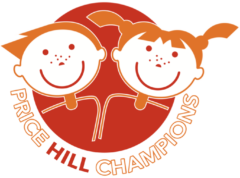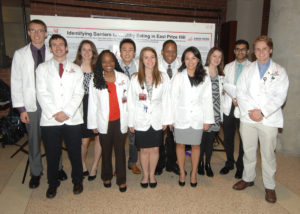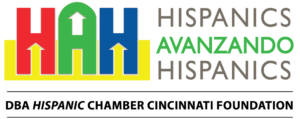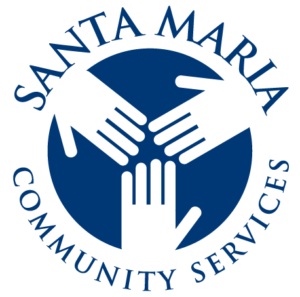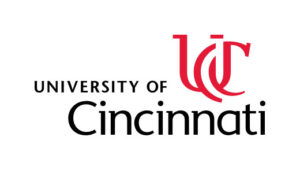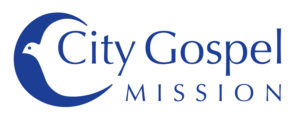Price Hill Champions Key Findings Report (Click here for PDF)
Erickson Andrews, Ethelin Cammock, Steven Chen, Travis Goettemoeller, Kathryn Hasselfeld, John Jones, Samantha Marek, Robert Mauger, Helen Shi, Raisa Tikhtman, Maneesh Tiwari
Introduction
East Price Hill is a neighborhood located two miles west of downtown Cincinnati. As of the most recent census, East Price Hill has 15,340 residents, of whom 52% are white, 38% are black, and 7% are Hispanic.1 The median family income is $30,896, which is 10% less than the median in Cincinnati ($34,116) and 36% less than the median in Ohio ($48,308).2 Eighteen percent of residents over the age of 25 have earned a college degree, compared to 31.5% for the city of Cincinnati and 25.2% for Ohio as a whole.1,2 The life expectancy for residents of East Price Hill is 70.8, which is nearly 6 years less than that of the average Cincinnati resident (76.6 years).1
Our community partner, Santa Maria Community Services is a non-profit organization that focuses on providing the Greater Price Hill area with resources to promote healthy living, strong families, and neighborhood revitalization. Their services target Hispanic/Latino populations and reach over 3,000 individuals annually. Santa Maria’s offerings include a youth development program, workforce development program, health and wellness program, early childhood development/parenting programs, and international welcome center.3
Determinant of Health
Representatives of Santa Maria informed us that nutrition is an area of wellness that still needs to be addressed in the East Price Hill community. This observation is consistent with recent studies in the region. For example, the 2013 Greater Cincinnati Community Health Status Survey found that only 19% of adults in Price Hill felt they ate the recommended daily amount of fruits and vegetables, and 50% reported eating fast food at least once per week.4 Our group conducted a focus group with parents of students at Roberts Academy to learn more about the needs of East Price Hill residents with respect to knowledge about the availability and preparation of healthy foods, in addition to barriers to accessing these items. Based on their responses, our group decided to focus on the impact of education and family assets on balanced, healthy eating as our determinant of health.
Service Learning Objectives
1. Develop an effective educational curriculum geared toward students in grades 4-8 2. Educate student participants on healthy eating, drug use prevention, and drug safety
Methods
Working with Santa Maria on ways to engage the community to address our determinant of health, we were put in contact with Daniel Minera of Amigo Ministries and an after-school program, Price Hill Champions, at Roberts Academy. The existing program combined soccer skills training with character building lessons for 4th-8th graders at the public school. Mr. Minera wanted to expand the program to include nutrition and drug use prevention lessons because he observed that students seemed to be lacking adequate exposure to these topics through the curriculum at Roberts Academy. Due to our last semester of work assessing nutritional knowledge and access in East Price Hill, we thought working with Mr. Minera to develop a targeted curriculum would provide a great means of designing an intervention that could impact its audience relatively early in their lives and thereby foster the development of lifelong habits conducive to sustainable nutritional health. By expanding the scope of the after-school program’s curriculum to include information on the negative health consequences of substance use, we hoped to augment the potential impact of the curriculum on the health of these students, surpassing the initial goals for our service-learning project.
Through meeting with Mr. Minera, we gained a sense of what he wanted to be included in the curriculum. He felt that there were no existing curriculums that met the educational needs of his students and wanted a new curriculum that could be meshed with the extant character-building and soccer skill provisions of Price Hill Champions. The program runs for two days a week over six weeks. The general schedule each day was to be an after-school snack, followed by a nutrition lesson for 15 minutes, drug prevention lesson for 15 minutes, soccer skills lesson for 45 minutes, and finally dinner with a talk on character traits. Mr. Minera was very open to what we thought would be best to teach them in each lesson, as any education on these topics would be better than none.
From there, we brainstormed possible topics to be included in the nutrition and drug use prevention elements of the curriculum. We researched existing curriculums to gain a sense of the core goals to be achieved by our project. As group members discussed the potential lessons, we soon realized that our time would be better spent having one day a week focus on nutrition and one day on drug prevention. That way, we could teach a total of six 30-minute lessons for each component of the curriculum. With longer lessons, we would have the ability to incorporate fun, hands-on activities that could actively engage the students in the material. We decided to cover the following topics for each subject: nutrition – macronutrients, the USDA’s MyPlate and serving sizes, how to read a nutrition label, sugar limitation, salt limitation, and healthy food options that taste good; drug use prevention and safety – tobacco, alcohol, marijuana, hard drugs, medicine and household chemical safety, and a final day for follow-up questions about drugs. We divided up the lessons so each member of our group was responsible for researching and designing one. Each lesson was built on a template that outlined general goals of the lesson, procedures, vocabulary, and materials needed. We designed a “teachers’ manual” version and a “student lesson” version for each topic. The teachers’ manual included a procedure on how to teach the lesson and discussion topics. The student lesson included copies of activity worksheets and learning outcomes with vocabulary words. After all lessons were created, we synthesized them into a booklet with uniform format and sent them to Mr. Minera for review and input. He took care of printing booklets for students in the after-school program.
As a learning community, we decided that we wanted to help implement the lessons that we had created, so we each signed up for one day to go to Roberts Academy and teach the indicated drug or nutrition lesson. Through this involvement, we were able to observe first-hand the strengths and weaknesses of the curriculum, but, more satisfyingly, we got to see the kids engaged and excited about the lessons we taught. We were also able to administer an assessment before and after the implementation of the curriculum to assess the knowledge of students related to its topics and the impact of our teachings. The pre- and post-tests were identical and consisted of one question derived from each lesson to assess all components of the program. The questions were multiple choice and each featured five answer options.
Results
Pre-test
The 42 students who attended the first day of the Price Hill Champions program were administered the pre-test. While the pre-test was comprised of eleven questions, the responses to the question on marijunana were not considered in our data analysis due to student confusion
about the layout of the question, leading to more than one response being selected. The average score on the remaining ten questions was 27%, with a standard deviation of 17%. As there were five answer options for each question, this result is just slightly better than students selecting answers at random. The individual student performances on the pre-test ranged from 0-70% correct. An analysis of the responses by question illustrated that no single question was answered correctly by more than 50% of students (Figure 1).
Post-test
The post-test was administered to 33 students. This time, the average score on the assessment (again, ignoring responses to the question on marijuana) was 39%, with a standard deviation of 19%. Individual results ranged from answer 0-80% of the questions correctly. Figure 2 illustrates the percent of students who answered correctly by question on the post-test, and Figure 3 displays the difference in accuracy rates for each question between the pre- and post- tests. Overall, student performance on the knowledge assessment improved consistently, except for the 4.3% decrease in correct responses on the question pertaining to nicotine/cigarette use. The greatest difference in the correct response rate was observed for the question on MyPlate (+29%), and the average change for the ten questions was +12%.
Discussion
The process of researching the design and content of effective curriculums and eventually creating one proved didactic for members of our learning community, most of whom had never engaged in a similar project previously. Tasked with coming up with individual lesson plans that had to fit together to create a cohesive product fit for implementation at a local school, each group member contributed significant amounts of time to this project. Furthermore, we all took part in the final implementation of our program at Roberts Academy, which allowed us to both interact with the audience of our curriculum and observe the outcomes of our work first-hand.
From the results of our pre-test, we confirmed that students in Price Hill Champions, ranging from grades 4-8, have a generally low baseline knowledge about nutrition and drug use prevention. It was established by Mr. Minera that the students at Roberts Academy do not receive adequate education at school about these topics, and he deduced qualitatively that they likewise do not have access to consistent sources of reputable information from outside the school. We designed the curriculum with the intention of providing students information on these topics so that they can build lifestyles around healthy decision-making, and the results of the post-test show that our curriculum holds promise for making a positive impact in the lives of Price Hill Champions participants.
At this point in the development of the curriculum, we could only assess general improvements in knoweldge, as measured by correct response rates to the questions on the pre- versus post- tests. The accuracy of this parameter was limited by the identify of the students who were present at the first versus last sessions of the program, for students sometimes missed sessions due to other commitments or family matters. As indicated by the number of subjects administered each of the two exams (42 took the pre-test; 33 took the post-test), we were unable to directly control this variable, in addition to the identity of students present for every lesson. At this point, we cannot quantify the extent to which survey results were affected by inconsistent student attendance at the after-school program. However, it must be noted that the number of students present at sesssions generally ranged from 30-40, thus we do not anticipate that many students missed more than one lesson.
Another inconsistency to report in the implementation of our curriculum relates to the identity of the learning community members delivering each lesson plan. In order to minimize the stressfulness and time commitment of the project, each member was asked to attend one Price Hill Champions session in order to implement their respective lesson plan. Thus, eleven different teachers were responsible for the delivery of different elements of the curriculum, which implies that there was much variation in how information was communicated and students were engaged. Based on the range of improvements in student knowledge observed for different topics covered in the curriculum, it is possible that these differences may be accounted for, at least in part, by the ways in which lessons were taught. Other explanations for these differences include varying levels of student interest in topics (for example, in alcohol use versus nutrition labels), the quality of individual lesson plans, or perhaps the presence of distractions on the day of a particular lesson.
Future Directions
Limitations to the project included student attention spans and volunteer needs of the program. Although we worked to incorporate engaging activities, maintaining the attention of 40+ 4th-8th grade students proved difficult, especially considering our group members’ relative inexperience with teaching. In the future, we would consider the ways in which we could improve the delivery of the lessons and potentially incorporate breakout groups or even more hands-on activities. Secondly, in order for the program to be sustainable, Price Hill Champions requires regular volunteers to teach the lessons. We think cultivating parent and community member interest in the program would help to identify additional sources of human resources, especially if volunteers were people who had a stake in the health of these students. As medical students, the members of our learning community will not be reliably available in the coming years to continue with the implementation of the curriculum, and thus it is essential that Price Hill Champions be supplied with a new source of dependable instructors for the program. We are committed to the cause of involving more adults in the community who feel invested in educating these students.
Finally, the big idea behind this curriculum is that it could be repeated yearly for each new class of students, as well as be adapted to meet the needs of other communities. Price Hill Champions could easily become “Walnut Hills Champions” or “Covington Champions” with the printing of booklets featuring a new title. The teachers’ manual contains easy-to-follow instructions on how to run the lessons, and it could easily be incorporated into other after-school programs. The minimal financial requirements of the curriculum, in addition to its easily manipulated digital format, make it additionally appealing as a program. We hope to impact many groups of students and improve health choices throughout the greater Cincinnati area through continued promotion of this product.
Conclusion
Through a community assessment last semester, we identified that nutrition is an area that could be improved in the community of East Price Hill. Working with Santa Maria and Amigo Ministries, we expanded an existing after-school soccer program to include lessons on nutrition and drug use prevention and safety for 4th-8th graders. Results from our pre-test confirmed that students do not already have knowledge on these areas, and our post-test results suggest that our curriculum may indeed provide a means of improving student awareness of key points related to nutrition and substance use prevention. Intervening early in students’ lives should ideally enable them with the tools to make choices that will allow them to build sustainable, healthy habits and knowingly avoid certain risks to their wellbeing. We hope that the lessons taught through the first iteration of the enhanced curriculum of Price Hill Champions can be sustained throughout each student’s life and contribute to improved health outcomes.
Acknowledgements
We wish to thank Luz Schemmel of Santa Maria Community Services, Daniel Minera of Amigo Ministries, and Dr. Kiesler of UCCOM for their continued support and contributions to this project.
Supported in part by USPHS Grant #1UL1TR001425-01 from the National Center for Research Resources, NIH.
References
- East Price Hill Statistical Neighborhood Approximation 2010 Census. City of Cincinnati City Planning Website. http://www.cincinnati-oh.gov/planning/linkservid/B4AEB68A-B22F- 200F-0EB19D550B6E482D/showMeta/0/.
- State and County Quickfacts for Cincinnati, Ohio. United States Census Website. http://quickfacts.census.gov/qfd/states/39/3915000.html. Updated December 2, 2015.
- Health and Wellness. Santa Maria Community Services Website. https://www.santamaria- cincy.org/programs/health/.
- Price Hill, The Health of Our Community. Interact for Health Website. https://www.interactforhealth .org/upl/Price_Hill_The_Health_of_Our_Community.pdf.
